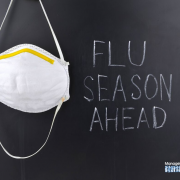How to Prepare for a Bad Flu Season with a Good Disinfection Program
So—do you want the good news or bad news first?
Bad news: Early reports show that this year’s flu season is not looking so good. There’s a particular strain—H3N2—which is said to be more severe.
Good news: With proper disinfection, cleaning teams can have a substantial impact on stopping the spread of the virus.
A few months ago, we talked about the “Hygiene Hypothesis” and how there’s no such thing as being too clean. Proper cleaning—and disinfection— is critical to preventing the spread of viruses and diseases outlined in that post.
But contrary to popular practice, disinfecting is about so much more than just misting an area and wiping it down several minutes later. In most non-critical environments, low-level and intermediate disinfection will do. Summary: HOW people clean is much more critical than WHAT they use to clean.
As we head into cold and flu season, now is a good time to refresh these basic principles of disinfectants with your team to make sure they work as intended:
- Consider the Tools: It may seem like a no-brainer, but if you’re cleaning to disinfect an area, you can’t use dirty tools. the tools you use can’t be dirty. And we’re not talking just “I can’t see dirt, so it must be clean” — freshly laundered cleaning cloths, mops and brushes must be used in order to prevent poor disinfection. Once the surface of the cloth has been used, fold it over to expose a clean side before wiping again.
- Follow Specified Dilution Ratios: We’ve all heard about the dangers of the “glug, glug” method where cleaners loosely follow dilution ratios by adding a “glug” of disinfectant to a few “glugs” of water. In some instances, cleaners may think that adding more disinfectant than called for is better. This approach is not only be dangerous to the cleaner, it can result in sticky or heavily soiled surfaces – which actually can become an even bigger breeding ground for pathogens . Always follow manufacturers’ directions when preparing a disinfectant.
- Clean, and Then Disinfect: If soil is present on a surface, it can cut down on the germicidal capabilities of a disinfectant. Use a one-step procedure to enable disinfectant cleaners achieve peak performance.
- Use Friction—and a Little Elbow Grease: According to the CDC, friction (e.g. scrubbing a hard surface with a brush) is an “old and dependable method for disinfecting hard surface. We’d go a step further and say it’s the most important component of a surface disinfection program. Cleaners should also put a little muscle into cleaning, as bacteria can mix with film and dirt on surfaces. When these are not removed, bacteria can also be left behind.
- Wipe in ONE direction. Try sprinkling some flour on a tabletop and wiping it in a circular motion with a slightly damp cloth. What happens? The flour just spreads around the table. When you wipe in a singular direction and continue to expose a clean surface, you are able to move toward the edge of the table and remove bacteria more effectively.
- Change Solutions Frequently: As a best practice, cleaners should use a two-sided mop bucket system. To ensure cleaners regularly change disinfectant solutions, set a hard rule on frequencies (e.g. change solution once every five rooms).
- Return Tools for Cleaning: After any disinfection occurs, it’s important to establish a protocol for cleaning equipment at the end of their shift so tools can be cleaned and dried. Mop heads should be returned to a designated barrel so they can be taken to a laundry and cleaned. Before each use, make sure mops are completely dry. Bacteria are not destroyed by laundry chemicals, but by the hot air of drying. Even slightly damp mops will harbor dangerous bacteria. The same holds true for squeegees or any other tools used in the cleaning process—make sure they are properly cleaned and inspected for tears, which can create places for bacteria to hide.
Always remember: the best disinfectant is a clean, dry surface.
For more information on disinfection, sanitization and best practices for cleaning, check out our book “Microbiology for Cleaning Workers Simplified” in the ManageMen store.



